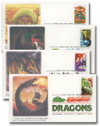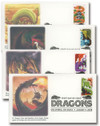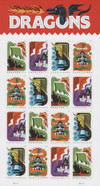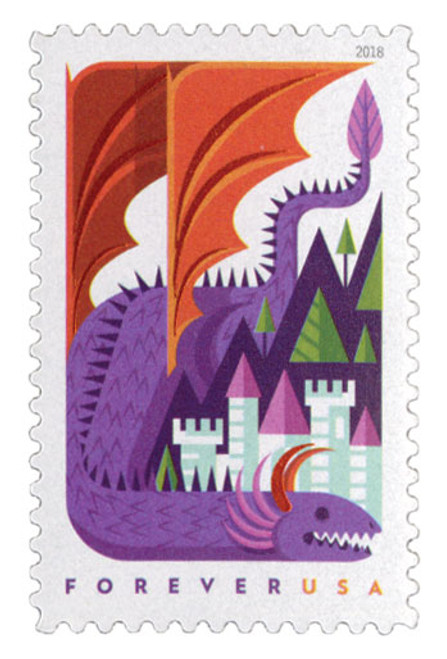
# 5307-10 - 2018 First-Class Forever Stamp - Dragons
U.S. #5307-10
2018 50¢ Dragons
In nearly every corner of the world, dragons appear in mythology, folklore, and literature. But their depictions and roles can vary as widely as the cultures in which they are found.
The oldest-known tales of dragons come from Mesopotamia. There, great kings were compared to a gigantic serpent monster sometimes called the “roaring weather beast.” Chinese and other early Asian cultures also deeply revered dragons as gods, particularly in relation to the weather. The Chinese word for dragon, lóng, is believed to be taken from the sound of thunder.
While dragons have been found in the ancient histories of many Western cultures, their influence was particularly significant during the Middle Ages. It was during this time that the modern image of a winged, four-legged, fire-breathing dragon became widespread.
In Eastern cultures, dragons are often peaceful, while in Western countries, they are usually beasts to be defeated. Regardless, dragons have been popular to include on flags and coats of arms, representing strength and power in all cultures.
Why do so many cultures around the world have tales of dragons? Historians suggest ancient people found the bones and fossils of dinosaurs and prehistoric animals and incorporated them into their folklore. Their discoveries gave rise to the dragons we know today.
U.S. #5307-10
2018 50¢ Dragons
In nearly every corner of the world, dragons appear in mythology, folklore, and literature. But their depictions and roles can vary as widely as the cultures in which they are found.
The oldest-known tales of dragons come from Mesopotamia. There, great kings were compared to a gigantic serpent monster sometimes called the “roaring weather beast.” Chinese and other early Asian cultures also deeply revered dragons as gods, particularly in relation to the weather. The Chinese word for dragon, lóng, is believed to be taken from the sound of thunder.
While dragons have been found in the ancient histories of many Western cultures, their influence was particularly significant during the Middle Ages. It was during this time that the modern image of a winged, four-legged, fire-breathing dragon became widespread.
In Eastern cultures, dragons are often peaceful, while in Western countries, they are usually beasts to be defeated. Regardless, dragons have been popular to include on flags and coats of arms, representing strength and power in all cultures.
Why do so many cultures around the world have tales of dragons? Historians suggest ancient people found the bones and fossils of dinosaurs and prehistoric animals and incorporated them into their folklore. Their discoveries gave rise to the dragons we know today.
















